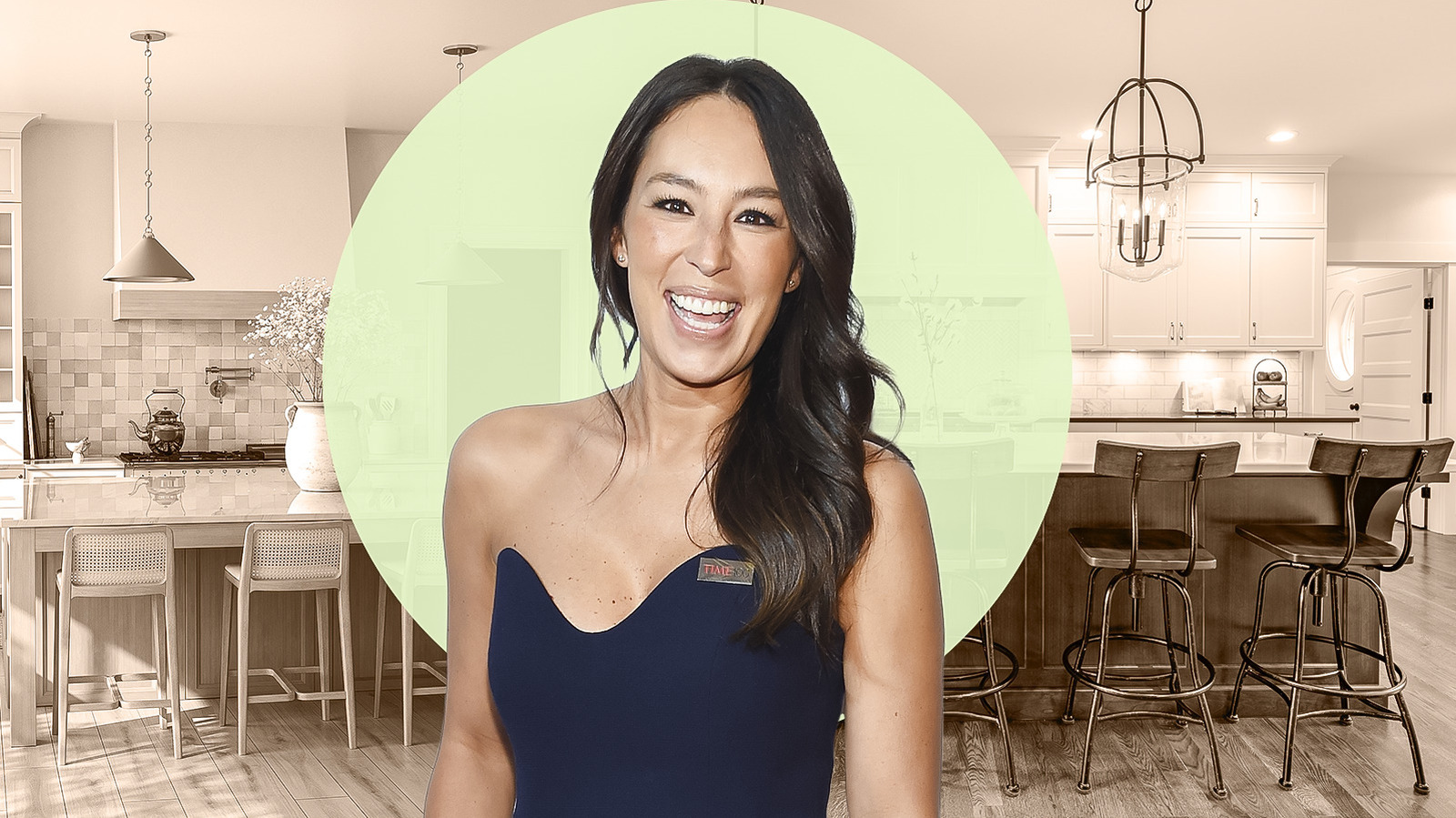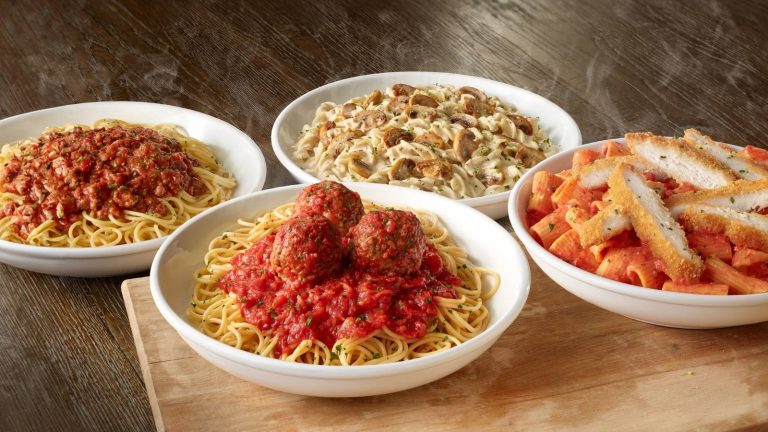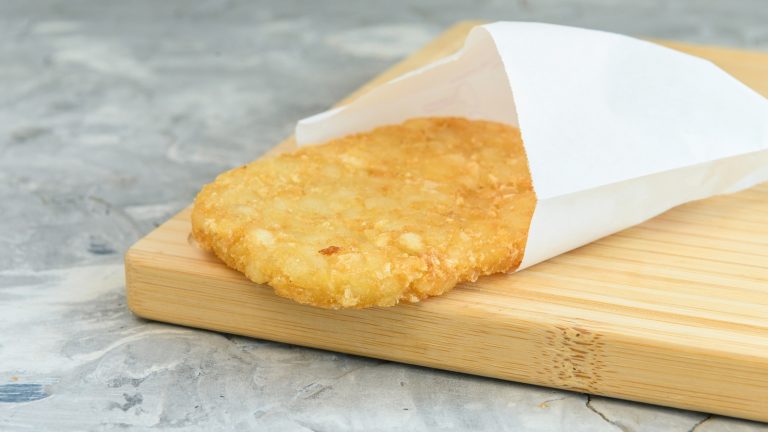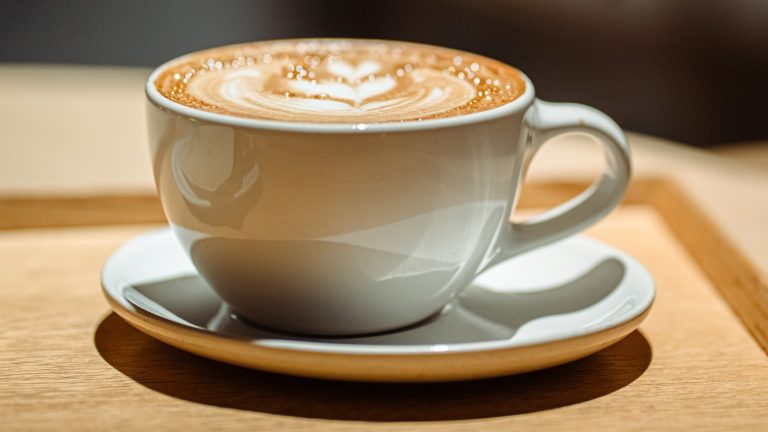We may receive a commission on purchases made from links.
Joanna Gaines, a name synonymous with timeless charm, is renowned for her signature modern farmhouse style rooted in rustic elegance. She rose to fame as the co-star of HGTV’s series “Fixer Upper,” where she starred alongside her husband Chip Gaines. Together, the duo transformed rundown properties into dream homes across Waco, Texas, and shared these transformations via the small screen. She has also released a series of cookbooks and launched her own home and lifestyle brand called Magnolia, which has become an e-tailing giant. The Magnolia range features a variety of curated home décor and furniture items, paint palettes, and wallpaper, with a particular focus on vintage-inspired fixtures and kitchenware, like cookware.
Her influence on kitchen design is far-reaching, with her ability to seamlessly blend old-world charm with contemporary flair. She has not only transformed other people’s kitchens as part of the “Fixer Upper” show, but her fans have also been treated to a closer look inside her own kitchens that she has remodelled and showcased on social media and in magazines. For anyone looking for inspiration to modernize their farmhouse-style kitchen without losing the rustic appeal, or for those looking to incorporate more vintage elements, Gaines’ design choices offer a masterclass in balance. Here, we highlight some of our favorite kitchen design features from this renowned interior decorator.
1. Outdoor elements brought indoors
A key element that Joanna Gaines often incorporates into her kitchen designs is to bring the natural environment inside. Whether she’s working with a lakeside property or a classic Texas farmhouse, Gaines is known for designing spaces that feel grounded, quite literally, in the world outside.
Her signature use of natural elements is not always as direct as adding large windows and skylights, but rather more about using a color palette that draws inspiration from nature or by using natural materials in features like flooring. An example of this is her work in “Fixer Upper: The Lakehouse,” where she worked toward restoring the home to its original midcentury modern and Spanish Revival style. In the kitchen, she introduced terra cotta floor tiles that featured a marble star, combining the Spanish influence with a midcentury touch.
Adding potted plants is another way to introduce the vibrant colors of nature into your kitchen, where it could be as simple as herbs or something more exotic, like the monstera lechleriana or the red Congo philodendron, which she has kept in her own home. In many of her “Fixer Upper“ reveals, you’ll find a lot of inspiration from the outside world, like natural wood finishes, organic shapes, and earthy colour palettes that create a connection to nature without feeling overtly rustic.
In an exclusive interview with Homes and Garden, she said, “‘I always tell my team when I get stuck from an inspiration standpoint, or I can’t figure out what the next step is, I always go outside. I don’t go online, I don’t look at books — I have to step outside. Nature is our greatest teacher with design because it does it so perfectly.”
2. Contrast in the kitchen
One of Joanna Gaines’ most recognizable design signatures is her masterful use of contrast. She does this particularly well with her use of paint in the kitchen space, using contrasting tones, such as white and black, to add depth and variety to a room. You’ll also often find Gaines using earthy colors around the kitchen, complemented in some cases by darker hues to contrast with the softer surrounding colors.
It’s the same in her furniture and décor selection in many kitchens. Using a type of juxtaposition, where two differing objects are placed close together to create disparity, she creates a well-balanced contrast and, in many cases, blends the old with the new.
Sometimes it’s simply about not using paint at all to create that contrast. Take her use of unfinished, unpainted kitchen cabinetry in the design of the on-set kitchen used to film her TV show “Magnolia Table.” The raw, bare kitchen cabinets were a nod to the vintage history of the 1800s-era property. Choices like this aren’t about being trendy; they’re about layering texture and tone in a way that feels timeless. Rather than feeling mismatched, Gaines carefully considers the contrasting colors, materials, and styles to blend comfort with character.
3. A combination of modern and rustic styles
Joanna Gaines has a way of making rustic kitchens feel anything but old and dated. She blends rustic warmth and modern luxury, a combination that has become a hallmark of her approach to country-style kitchens.
It’s not about introducing the latest technology-infused appliances into a kitchen space to give it a modern touch, but rather drawing on elements like marble, clean lines, open concepts, and natural light. In her “Fixer Upper: The Lakehouse“ kitchen redesign, she used marble for the countertop and backsplash, while natural cherry wood is prominently featured. The warm wooden accents give the kitchen a mid-century modern feel, while the marble material adds a sophisticated touch.
Sometimes, she also blends functionality with this design style, as seen in Gaines’ castle kitchen, an early 20th-century property that she and her husband Chip bought in Waco, Texas. The couple set out to refurbish the home, with one key area being the kitchen. Some industry experts have described the redesign as exemplary of modern country, and it’s easy to understand why. Doubling as an island, an antique table is both functional and practical, while a dumbwaiter is transformed into a spice rack. To add contemporary to the mix, Gaines installed custom cabinetry. These are just two of many instances of how she transformed a vintage kitchen into one that is both modern and functional.
4. The farmhouse sink
If you’re wondering which sink to choose for your kitchen, Joanna Gaines is a great source of inspiration. She’s a big fan of the farmhouse sink — in fact, she’s been credited with playing a key role in its revival. It’s one of the few design elements that capture the charm of a vintage kitchen and one that creates a wonderful blend of modern and rustic. Today, you’ll find these sinks in most homes that have been designed in a modern farmhouse style.
Also known as an apron-front sink, this style traces its roots back to the 17th century, when its extra-deep basin made everyday tasks like washing dishes, vegetables, or even laundry more manageable. Today, thanks to the influence of interior designers like Gaines, the farmhouse sink has become a symbol of rustic elegance and practical beauty. Following the appearances of these sinks in “Fixer Upper,“ many have been inspired by Gaines’ style to have these sinks fitted in their own homes.
What’s great about a farmhouse sink is that it can serve as an eye-catching centrepiece, seamlessly blending with features like natural wood cabinetry, shiplap walls, and vintage-inspired fixtures. If you’re looking to make a kitchen design statement, this may be one item you should consider installing in your kitchen. They come in various materials to match the overall aesthetic of a kitchen, including stainless steel, granite, porcelain, fireclay, and more.
5. Vertical shiplap
Shiplap has become synonymous with Joanna Gaines’ distinctive design aesthetic, particularly in her kitchen transformations. Originally used in maritime construction for its watertight properties, shiplap has found new life as a charming interior feature. Basically, shiplap is a type of wooden board with overlapping grooves that fit together snugly, which is not only great for insulation but also for adding a rustic texture to interior walls.
While shiplap was used as insulation in farmhouse-style homes for some time, Gaines was a key influencer who made it very popular around 2015 in the U.S. as an interior design feature in homes, particularly in the kitchen. It’s one of the farmhouse chic styles that she is so well known for, one that is timeless and hardy. Whether it’s a full accent wall, a backsplash alternative, or even ceiling paneling, shiplap adds a layer of depth and character to a room.
Gaines has also experimented with the orientation of shiplap boards. While they are most often installed horizontally, she sometimes places the boards vertically to draw the eye upward, making spaces feel taller and more open. The vertical style adds to the vintage look, whereas the horizontal placement is more modern. This is a simple yet effective way of transforming a clinical or stale kitchen into one that blends a rustic style with that of a modern farmhouse design.
6. White marble features
A recurring feature in Joanna Gaines’ kitchen designs is her deliberate use of white marble, a material that instantly elevates any space with its clean, timeless appeal. Known for its subtle veining and naturally luminous surface, white marble has long been associated with sophistication and luxury. While it’s been used in countertops for many years, Gaines goes beyond the traditional by using the metamorphic rock in a variety of kitchen features.
What makes her use of marble stand out is how she often pairs it with organic and rustic materials. Instead of leaning into a cold, hyper-modern aesthetic, she softens the luxury of marble with reclaimed wood or pairs it with dark cabinets.
While she is a fan of white marble countertops, she also uses the material in fireplace features, around kitchen sinks, as trays, and more. The introduction of white marble as a backsplash, a great alternative to white subway tiles in the kitchen, received particular attention, with some media outlets saying it was a trend to watch out for. It’s yet another way to blend rustic elements with modern sophistication in a kitchen. If you opt for white marble in your kitchen, you don’t always have to make it a significant feature like a tabletop. You could incorporate it in a more subtle way, such as in coasters, cabinet handles, and more.
7. Vintage furniture and decor
Joanna Gaines’ kitchens often feel like they’ve existed for generations — and that’s largely thanks to her tactful placement of vintage furniture and decor. These pieces don’t appear old and outdated, though, as she blends them in with modern features, creating the right balance of contrast between old and new that she is so well known for.
Rather than relying on built-in cabinetry or mass-produced fixtures, she often adds standalone, antique pieces that inject warmth, charm, and a sense of history into the space. Gaines finds vintage furniture that not only adds to the style of the kitchen but also has a practical use. An antique hutch is a great example of how she achieves this. She uses a vintage hutch to not only add character to a space but also to double as a storage area for retro glassware or other tableware.
For your own kitchen, consider a vintage piece topped with glass canisters or alongside open shelving, or adding vintage jars or coffee sets to a marble counter. You can find a lot of these items in antique malls or resale shops. A quick Google search will also bring up a variety of options in your area. Gaines has also launched her own vintage collection, under the name Found & Collected, which forms part of her Magnolia brand.
8. Antique wooden cabinet doors
Joanna Gaines seems to have a knack for starting trends — whether that be installing unpainted cabinets as was the case last year, or using antique wooden cabinet doors in the kitchen. The latter design choice is often something you’ll find in a Gaines-inspired home, where antique doors are proudly displayed in the kitchen. It’s not only Gaines who is shining the light on this trend, but other interior designers as well. A key driver may be that this is also an eco-friendly alternative for those looking to be more sustainable in their home.
Rather than choosing modern, high-gloss finishes or uniform panels, Gaines often selects antique wooden cabinet doors to add more character and appeal to kitchen spaces. These reclaimed or vintage pieces become a defining feature of the room — a nod to craftsmanship from a bygone era.
If you’re looking to get your hands on antique doors for your cabinets, take a look at your local antique shop or consider browsing through online marketplaces. You might not find the doors by themselves, but purchasing an entire cabinet just for the doors can be worth it. Just make sure to measure the space before you go ahead and buy them.
9. Dark color accents
While Joanna Gaines often makes use of soft neutrals and farmhouse whites, she has also made a bold case for the use of black and other dark accents in kitchen design. A color like black is not often associated with a kitchen space, with most people playing it safe using lighter color schemes. For Gaines, though, this color selection ties nicely into her focus on creating contrast in a space, and what better color to achieve this than with a dark hue like black.
In this Instagram post, you can see how she’s incorporated the dark color into the walls of a back kitchen, complemented by light colored seating, a marble table, and a cream light fixture. People seemed to love it, with the post receiving over 26,000 likes. This is just one of the many times Gaines used dark colors to create contrast.
If this is something you’re interested in incorporating into your home, don’t forget to consider everything in the room, as each element will interact with the dark paint. On her Magnolia website, Gaines explains how you can balance out bold shades with other elements, whether that be a chair, table, or décor pieces, exactly as she did with the back kitchen. It’s not for everyone, but this is one design feature that will make your kitchen a bit more bougie.
10. Vintage-inspired French rolling pin
While Joanna Gaines is a renowned interior decorator, she’s also made a name for herself as a foodie. There are many videos of her sharing some of her favorite recipes and showing the practical uses of the kitchens she designs. She particularly likes baking and often makes food with her children.
An item spotted in one of her cooking videos, a French-inspired rolling pin, got some attention. If you follow her on Instagram, you’ll find this item in a few of her posts. Gaines is no stranger to French-inspired design, as seen in an episode of “Fixer Upper” where she turned a Texas home into one that would be perfectly suited in the French countryside. It’s no surprise, then, that she’s a fan of this rolling pin.
These marble rolling pins are great for all kinds of baking, but when it comes to the best rolling pins for puff pastry, those made with marble are perfectly suited, as you can cool them in the fridge before rolling. This keeps the puff pastry temperature low. They also make great decor items that can add a vintage touch to your kitchen. A well-placed marble rolling pin on the kitchen countertop or on an open shelf can be a great complement to the rest of the space. If you’re looking to get your hands on a marble rolling pin, Amazon has a great selection.
11. Wrought iron fixtures and décor
You’ll see quite a lot of wrought iron being used in Joanna Gaines’ designs, particularly in light fixtures. It’s another example of how she leans into contrasts, using the wrought iron alongside wood, glass, and other materials. It also, once again, highlights her focus on incorporating vintage details, as wrought iron is used in mid-century modern design and in Victorian-era design.
She incorporates this material throughout a home, including in the kitchen, whether it be stair railings, chandeliers, kitchen chairs, wall organizers, hooks, or shelving brackets. Her use of this metal is mostly subtle, applying it not as a dominant feature but rather to complement the material it sits on or alongside. For instance, some of her open shelving designs feature raw wood with wrought iron brackets.
If you’re looking to introduce some wrought iron into your kitchen, you’ll find a selection of products featuring the metal on Gaines’ Magnolia website, or you can browse the various shops in your area. The trick is to find furniture or décor where wrought iron is combined with other materials, whether that be glass or wood.
12. Layered kitchen lighting
While a Joanna Gaines kitchen design is synonymous with contrast and the combination of modern and rustic, she is also well known for using layered lighting in a kitchen space. Instead of relying on a single overhead fixture, Gaines creates depth and warmth by combining various types of lighting — pendants, sconces, recessed lights, and even lamps — to suit both function and mood. It’s not just about brightness; it’s about atmosphere.
One of the ways she achieves this, especially in a small kitchen, is to install lighting beneath cabinets. By doing so, she adds dimension to the space and creates the illusion that the kitchen is bigger than it actually is. It’s a great trick to make your kitchen seem larger.
Layered lighting also lets her play with contrast. She often mixes warm, vintage-style Edison bulbs with cool-toned finishes or blends wrought iron details with soft, diffused glows to keep a space from feeling too bland. For Gaines, lighting isn’t just practical — it’s also about the senses, making a space feel cozy and warm as opposed to clinical.





